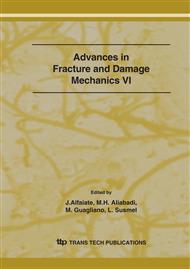p.29
p.33
p.37
p.41
p.45
p.49
p.53
p.57
p.61
Automatic 3-D Crack Propagation Calculations in Industrial Components: A Pure Hexahedral versus a Combined Hexahedral-Tetrahedral Approach
Abstract:
In recent years, increased loading and low weight requirements have led to the need for automatic crack tracing software. At MTU a purely hexahedral code has been developed in the nineties for Mode-I applications. It has been used extensively for all kinds of components and has proven to be very flexible and reliable. Nevertheless, in transition regions between complex components curved cracks have been observed, necessitating the development of mixed-mode software. Due to the curvature of the crack faces, purely hexahedral meshes are not feasible, and therefore a mixture of hexahedral elements at the crack tip, combined with tetrahedral in the remaining structure has been selected. The intention of the present paper is to compare both methods and to point out the strength and weaknesses of each regarding accuracy, complexity, flexibility and computing time. Furthermore, difficulties arising from the out-of-plane growth of the crack such as the determination of the crack propagation direction are discussed.
Info:
Periodical:
Pages:
45-48
Citation:
Online since:
September 2007
Authors:
Price:
Сopyright:
© 2007 Trans Tech Publications Ltd. All Rights Reserved
Share:
Citation:


